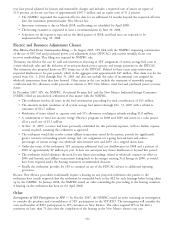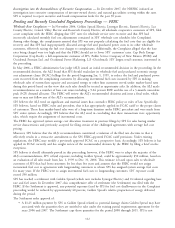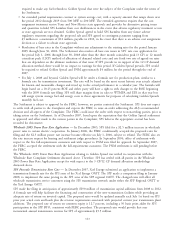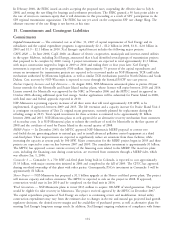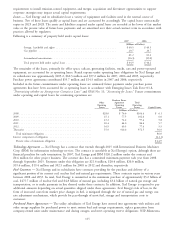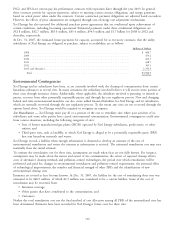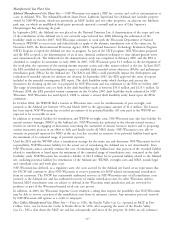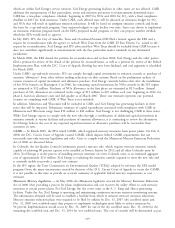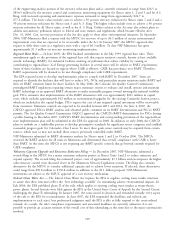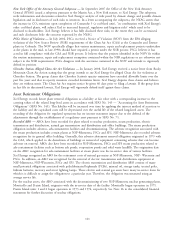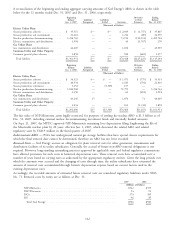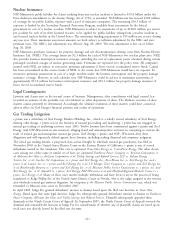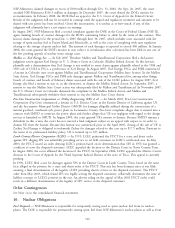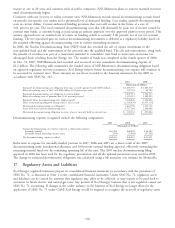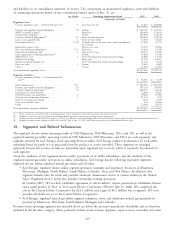Xcel Energy 2007 Annual Report Download - page 129
Download and view the complete annual report
Please find page 129 of the 2007 Xcel Energy annual report below. You can navigate through the pages in the report by either clicking on the pages listed below, or by using the keyword search tool below to find specific information within the annual report.which are within Xcel Energy’s service territory. Xcel Energy generating facilities in other states are not affected. CAIR
addresses the transportation of fine particulates, ozone and emission precursors to nonattainment downwind states.
CAIR has a two-phase compliance schedule, beginning in 2009 for NOx and 2010 for SO2, with a final compliance
deadline in 2015 for both emissions. Under CAIR, each affected state will be allocated an emissions budget for SO2
and NOx that will result in significant emission reductions. It will be based on stringent emission controls and forms
the basis for a cap-and-trade program. State emission budgets or caps decline over time. States can choose to implement
an emissions reduction program based on the EPA’s proposed model program, or they can propose another method,
which the EPA would need to approve.
In July 2005, SPS, the City of Amarillo, Texas and Occidental Permian LTD filed a lawsuit against the EPA and a
request for reconsideration with the agency to exclude West Texas from the CAIR. El Paso Electric Co. joined in the
request for reconsideration. Xcel Energy and SPS advocated that West Texas should be excluded from CAIR because it
does not contribute significantly to nonattainment with the fine particulate matter standards in any downwind
jurisdiction.
In March 2006, the EPA denied the petition for reconsideration and in June 2006, Xcel Energy and the other parties
filed a petition for review of the denial of the petition for reconsideration, as well as a petition for review of the Federal
Implementation Plan, with the D.C. Court of Appeals. Briefing has now been finalized, and oral argument is scheduled
for March 2008.
Under CAIR’s cap-and-trade structure, SPS can comply through capital investments in emission controls or purchase of
emission ‘‘allowances’’ from other utilities making reductions on their systems. Based on the preliminary analysis of
various scenarios of capital investment and allowance purchase, Xcel Energy currently believes that after the installation
of low NOx burners on Harrington 3 in 2006, the remaining capital investments for NOx controls in the SPS region
are estimated at $12 million. Purchases of NOx allowances in the first phase are estimated at $8.9 million. Annual
purchases of SO2 allowances are estimated in the range of $13 million to $25 million each year, beginning in 2012, for
phase I, based on allowance costs and fuel quality as of March 2007. These cost estimates represent one potential
scenario on complying with CAIR, if West Texas is not excluded.
In addition, Minnesota and Wisconsin will be included in CAIR, and Xcel Energy has generating facilities in these
states that will be impacted. Preliminary estimates of capital expenditures associated with compliance with CAIR in
Minnesota and Wisconsin range from $30 million to $40 million. Xcel Energy is not challenging CAIR in these states.
While Xcel Energy expects to comply with the new rules through a combination of additional capital investments in
emission controls at various facilities and purchases of emission allowances, it is continuing to review the alternatives.
Xcel Energy believes the cost of any required capital investment or allowance purchases will be recoverable from
customers in rates.
CAMR — In March 2005, the EPA issued CAMR, which regulated mercury emissions from power plants. On Feb. 8,
2008, the D.C. Circuit Court of Appeals vacated CAMR, which impacts federal CAMR requirements, but not
necessarily state-only mercury legislation and rules. Costs to comply with the Minnesota Mercury Emissions Reduction
Act of 2006 are discussed below.
In Colorado, the Air Quality Control Commission passed a mercury rule, which requires mercury emission controls
capable of achieving 80 percent capture to be installed at Pawnee Station by 2012 and all other Colorado units by
2014. Xcel Energy is in the process of installing mercury monitors on seven Colorado units at an estimated aggregate
cost of approximately $2.6 million. Xcel Energy is evaluating the emission controls required to meet the new rule and
is currently unable to provide a capital cost estimate.
In the SPS region, the Texas Commission on Environmental Quality (TCEQ) adopted by reference the EPA model
program Given the many uncertainties created by decision of the D.C. Circuit Court of Appeals to vacate the CAMR,
it is not possible at this time to provide an accurate summary of applicable federal mercury requirements or cost
estimates.
Minnesota Mercury Legislation — In May 2006, the Minnesota legislature enacted the Mercury Emissions Reduction
Act of 2006 (Act) providing a process for plans, implementation and cost recovery for utility efforts to curb mercury
emissions at certain power plants. For Xcel Energy, the Act covers units at the A. S. King and Sherco generating
facilities. Under the Act, Xcel Energy is operating and maintaining continuous mercury emission monitoring systems.
The information obtained will be used to establish a baseline from which to measure mercury emission reductions.
Mercury emission reduction plans were required to be filed by utilities by Dec. 31, 2007 (dry scrubbed units) and
Dec. 31, 2009 (wet scrubbed units) that propose to implement technologies most likely to reduce emissions by
90 percent. Implementation would occur by Dec. 31, 2009 for one of the dry scrubbed units, Dec. 31, 2010 for the
remaining dry scrubbed unit and Dec. 31, 2014 for wet scrubbed units. The cost of controls will be determined as part
119




